Oh! Nuts ◊ Bulk Nuts & Seeds ◊ Bulk Macadamia Nuts
Bulk Macadamia Nuts
Browse our complete selection of Bulk Macadamia Nuts
 | |||
 | |||
 | |||
 | |||
Ultimate Guide to Nuts
MACADAMIA NUTS
A complete guide Introduction
According to a survey made by the Hawaiian Macadamia Nut Producers Association, three out of four Americans have never heard of the macadamia nut, and seven out of eight have never tasted it. The macadamia nut is virtually unknown in Europe, as well as in many parts of the Far East, Latin America and Africa. It is a difficult crop to grow, requiring considerable capital and patience on the part of the grower, since a period of at least ten to twelve years must elapse before the original costs of a macadamia orchard can be recovered. Moreover, there is a dearth of locales where the crop can grow successfully. In Hawaii, labor can cost as much as $32.00 per day, and though this is more than ten times as expensive as in many tropical regions of Latin America, Africa and the Orient, it is offset by significantly higher yields and superior agricultural results. It has been established that, in general, there are no successful macadamia plantations closer to the equator than 15° N or S. Macadamia differs from coffee in that with regard to coffee a suitable altitude can be substituted for latitude, whereas with regard to macadamia this is not applicable.
The macadamia nut is a rarity in another respect. Many important food plants have been cultivated by man for thousands of years. In the Old World it was common to grow wheat, rice, barley, onions, tea, apples, olives and almonds. In the New World corn, sweet potatoes, cacao and kidney beans were under cultivation. But macadamia is the only crop which was domesticated for the first time in 1858, in Australia. It is the only native Australian plant ever developed as a commercial food crop.
The macadamia is an evergreen tree of the family Proteaceae. It is indigenous to the coastal, subtropical rain forests of southeast Queensland and northern New South Wales in eastern Australia. Before 1850 the nut was known only to aboriginal tribes, who were gathering macadamia nuts each autumn since ancient times. In all probability they never cultivated the trees. Heaps of macadamia nut shells were found by the early white settlers in Australia near aboriginal feasting grounds. Macadamia was probably only a minor food for these aborigines who, depending on their territory, had several different common names for it.
Edible macadamia nuts are produced by two species of the genus Macadamia: M. integrifolia, known as the smooth-shell type, and M. tetraphylla, commonly referred to as the rough-shell type. Prior to 1956 the former was often called M. ternifolia v. integrifolia, while the latter was simply called M. ternifolia. These designations are no longer used for the edible varieties. M. ternifolia now applies to one of the eight other non-commercial or wild species of macadamia which exist. The kernels of these minor species are for the most part small, bitter and inedible, due to the presence of a cyanogenic glucoside.
Both of the edible species of Macadamia, if well-grown, may reach a height of sixty feet and a spread of some forty feet. Their glossy, dark green leaves resemble holly. The leaves of integrifolia, or smooth-shell type, are four to twelve inches long, growing in whorls of three, while its flowers are creamy white. Tetraphylla, or rough-shell type, has leaves from five to twenty inches long, with spines along their entire length. As its name implies, its leaves are usually found in whorls of four. The flowers of tetraphylla may be pink or creamy white. Both these species hybridize when growing in close proximity to each other. Most macadamia trees are capable of producing self-pollinated fruit, but nut production is higher when two or more cultivars are planted near each other.
The fruit consists of a fleshy husk which encloses a spherical seed, ½ inch to 1-¼ inch in diameter. Inside the hard, durable shell is the kernel, or macadamia nut, whose distinctive flavor has been compared to that of a superfine filbert. Under favorable conditions the macadamia begins to produce in six or seven years. It is a long-lived tree which may have a productive life of 60 years or more. In full production, well-grown mature trees may annually yield sixty to one-hundred fifty pounds or more of in-shell nuts.
How is macadamia grown?
The most important factor in successful propagation of macadamia is choosing a suitable site. The tree thrives best without shade, in mild, frost-free, subtropical climates. It requires at least 50? of well-distributed rainfall annually. Good drainage and protection from strong winds are vital. In Guatemala, a promising six-year-old macadamia orchard of 700 acres was virtually destroyed overnight in 1978 by an unexpected 70mph wind storm, which blew down 90% of the grafted trees.
In Hawaii macadamias thrive in elevations ranging from sea level up to 2,000 feet above sea level. If there is less than 50? of rain per year it is advisable to supplement water by irrigation. Weeds are controlled through the use of approved herbicides, and fertilization is necessary for growth and nut production. Fertilizer is applied at least three times a year, increasing it in proportion to the size and productivity of the tree. Strict measures must be taken to control the spread of diseases and pests, if the trees are at risk.
All of the commercial macadamia orchards in Hawaii are planted with grafted trees of M. integrifolia, the smooth-shell type. Trees are first kept in the nursery for two years, before being moved into the field for their final position. After being planted in the field it takes about five years for a tree to start producing a small crop, with production increasing at an accelerated rate, until full production is reached in the twelfth to fifteenth year. At that point, an annual yield of fifty to one-hundred fifty pounds of in-shell nuts per tree may be expected.
Spacing between trees varies in Hawaii. With standard sized trees, the recommended spacing is about 25 to 35 feet between the rows, and 18 to 25 feet between the trees in a row. Closer spacings may require thinning or heavy pruning to avoid excessive crowding of the trees.
Before the nuts drop, the ground should be cleared of weeds, debris, fallen leaves, branches and other obstructions. Since labor in Hawaii is scarce and expensive, various experiments have been made throughout the years to mechanize macadamia orchard operations. Large vacuum cleaners were tried, but this method did not work out well, as too much dirt and foreign matter were sucked up along with the nuts. Plastic netting supported between the trees to funnel the falling nuts into a collection point was found to be too expensive; moreover, leaves and branches fell into the nets, causing snarls. Tree shakers have to be used with great care since the nuts naturally fall off the tree only when they are mature, but vigorous shaking of the tree may cause immature, green nuts to fall, along with the ripe nuts. In many orchards that have flat surfaces, nuts are picked up off the ground by a mechanical harvester which passes up and down the rows. Brushes push the nuts onto a conveyor, which deposits them in a bin or trailer. However, some hand labor is always necessary. During harvest season the nuts should be picked up every six to eight weeks to avoid deterioration of the final product.

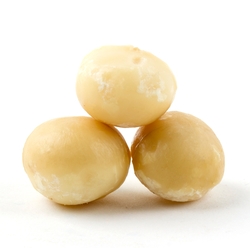



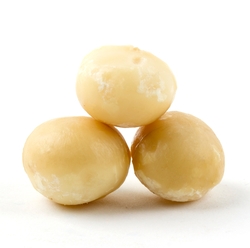
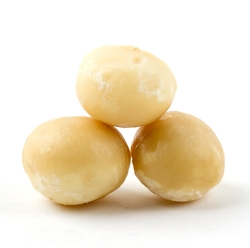
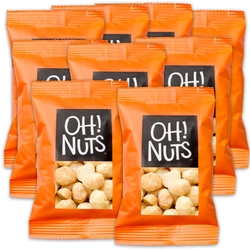
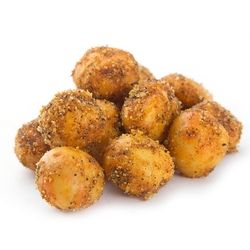
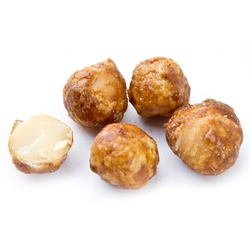
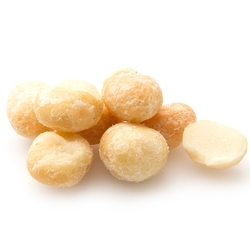
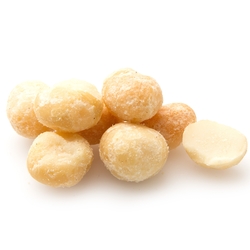
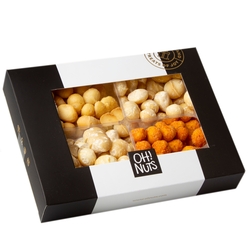
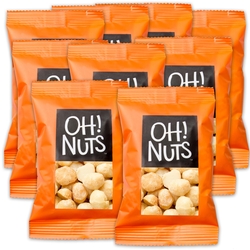
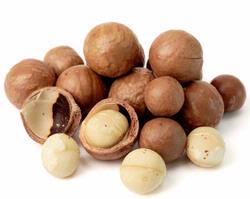
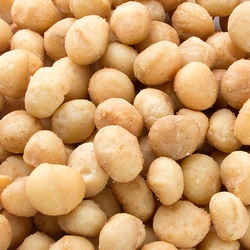
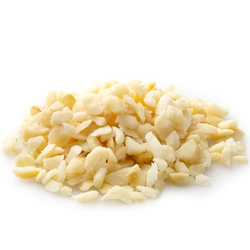
 or
or 
